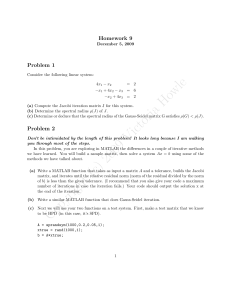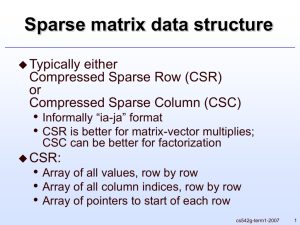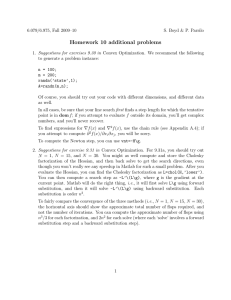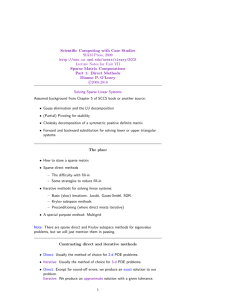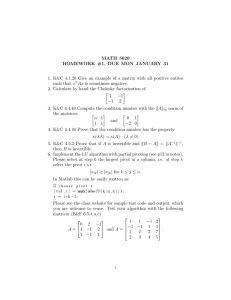Parallel Numerical Algorithms Chapter 7 – Cholesky Factorization Prof. Michael T. Heath
advertisement
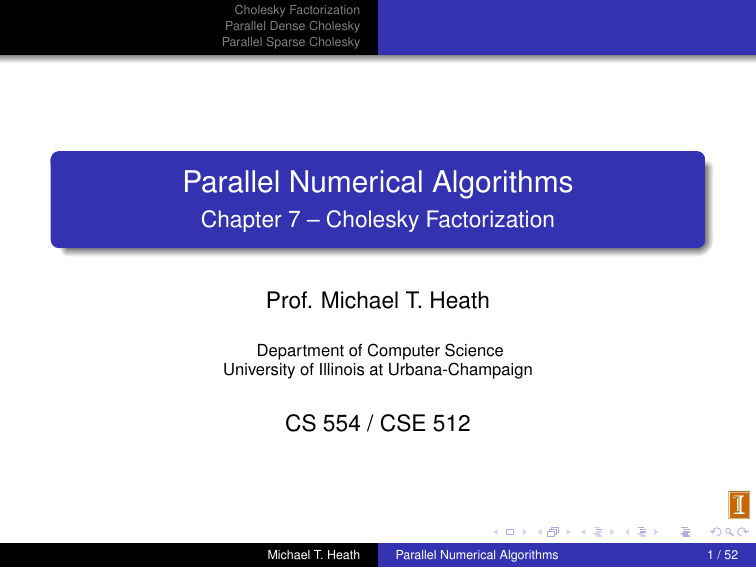
Cholesky Factorization
Parallel Dense Cholesky
Parallel Sparse Cholesky
Parallel Numerical Algorithms
Chapter 7 – Cholesky Factorization
Prof. Michael T. Heath
Department of Computer Science
University of Illinois at Urbana-Champaign
CS 554 / CSE 512
Michael T. Heath
Parallel Numerical Algorithms
1 / 52
Cholesky Factorization
Parallel Dense Cholesky
Parallel Sparse Cholesky
Outline
1
Cholesky Factorization
2
Parallel Dense Cholesky
3
Parallel Sparse Cholesky
Michael T. Heath
Parallel Numerical Algorithms
2 / 52
Cholesky Factorization
Parallel Dense Cholesky
Parallel Sparse Cholesky
Cholesky Factorization
Computing Cholesky
Cholesky Algorithm
Cholesky Factorization
Symmetric positive definite matrix A has Cholesky
factorization
A = LLT
where L is lower triangular matrix with positive diagonal
entries
Linear system
Ax = b
can then be solved by forward-substitution in lower
triangular system Ly = b, followed by back-substitution in
upper triangular system LT x = y
Michael T. Heath
Parallel Numerical Algorithms
3 / 52
Cholesky Factorization
Parallel Dense Cholesky
Parallel Sparse Cholesky
Cholesky Factorization
Computing Cholesky
Cholesky Algorithm
Computing Cholesky Factorization
Algorithm for computing Cholesky factorization can be
derived by equating corresponding entries of A and LLT
and generating them in correct order
For example, in 2 × 2 case
`11 0
`11 `21
a11 a21
=
a21 a22
`21 `22
0 `22
so we have
`11 =
√
a11 ,
`21 = a21 /`11 ,
Michael T. Heath
`22
q
= a22 − `221
Parallel Numerical Algorithms
4 / 52
Cholesky Factorization
Parallel Dense Cholesky
Parallel Sparse Cholesky
Cholesky Factorization
Computing Cholesky
Cholesky Algorithm
Cholesky Factorization Algorithm
for k = 1 to n
√
akk = akk
for i = k + 1 to n
aik = aik /akk
end
for j = k + 1 to n
for i = j to n
aij = aij − aik ajk
end
end
end
Michael T. Heath
Parallel Numerical Algorithms
5 / 52
Cholesky Factorization
Parallel Dense Cholesky
Parallel Sparse Cholesky
Cholesky Factorization
Computing Cholesky
Cholesky Algorithm
Cholesky Factorization Algorithm
All n square roots are of positive numbers, so algorithm
well defined
Only lower triangle of A is accessed, so strict upper
triangular portion need not be stored
Factor L is computed in place, overwriting lower triangle of
A
Pivoting is not required for numerical stability
About n3 /6 multiplications and similar number of additions
are required (about half as many as for LU)
Michael T. Heath
Parallel Numerical Algorithms
6 / 52
Cholesky Factorization
Parallel Dense Cholesky
Parallel Sparse Cholesky
Parallel Algorithm
Loop Orderings
Column-Oriented Algorithms
Parallel Algorithm
Partition
For i, j = 1, . . . , n, fine-grain task (i, j) stores aij and
computes and stores
`ij , if i ≥ j
`ji , if i < j
yielding 2-D array of n2 fine-grain tasks
Zero entries in upper triangle of L need not be computed
or stored, so for convenience in using 2-D mesh network,
`ij can be redundantly computed as both task (i, j) and
task (j, i) for i > j
Michael T. Heath
Parallel Numerical Algorithms
7 / 52
Cholesky Factorization
Parallel Dense Cholesky
Parallel Sparse Cholesky
Parallel Algorithm
Loop Orderings
Column-Oriented Algorithms
Fine-Grain Tasks and Communication
a11
ℓ11
a21
ℓ21
a31
ℓ31
a41
ℓ41
a51
ℓ51
a61
ℓ61
a21
ℓ21
a22
ℓ22
a32
ℓ32
a42
ℓ42
a52
ℓ52
a62
ℓ62
a31
ℓ31
a32
ℓ32
a33
ℓ33
a43
ℓ43
a53
ℓ53
a63
ℓ63
a41
ℓ41
a42
ℓ42
a43
ℓ43
a44
ℓ44
a54
ℓ54
a64
ℓ64
a51
ℓ51
a52
ℓ52
a53
ℓ53
a54
ℓ54
a55
ℓ55
a65
ℓ65
a61
ℓ61
a62
ℓ62
a63
ℓ63
a64
ℓ64
a65
ℓ65
a66
ℓ66
Michael T. Heath
Parallel Numerical Algorithms
8 / 52
Cholesky Factorization
Parallel Dense Cholesky
Parallel Sparse Cholesky
Parallel Algorithm
Loop Orderings
Column-Oriented Algorithms
Fine-Grain Parallel Algorithm
for k = 1 to min(i, j) − 1
recv broadcast of akj from task (k, j)
recv broadcast of aik from task (i, k)
aij = aij − aik akj
end
if i = j then
√
aii = aii
broadcast aii to tasks (k, i) and (i, k), k = i + 1, . . . , n
else if i < j then
recv broadcast of aii from task (i, i)
aij = aij /aii
broadcast aij to tasks (k, j), k = i + 1, . . . , n
else
recv broadcast of ajj from task (j, j)
aij = aij /ajj
broadcast aij to tasks (i, k), k = j + 1, . . . , n
end
Michael T. Heath
Parallel Numerical Algorithms
9 / 52
Cholesky Factorization
Parallel Dense Cholesky
Parallel Sparse Cholesky
Parallel Algorithm
Loop Orderings
Column-Oriented Algorithms
Agglomeration Schemes
Agglomerate
Agglomeration of fine-grain tasks produces
2-D
1-D column
1-D row
parallel algorithms analogous to those for LU factorization,
with similar performance and scalability
Rather than repeat analyses for dense matrices, we focus
instead on sparse matrices, for which column-oriented
algorithms are typically used
Michael T. Heath
Parallel Numerical Algorithms
10 / 52
Cholesky Factorization
Parallel Dense Cholesky
Parallel Sparse Cholesky
Parallel Algorithm
Loop Orderings
Column-Oriented Algorithms
Loop Orderings for Cholesky
Each choice of i, j, or k index in outer loop yields different
Cholesky algorithm, named for portion of matrix updated by
basic operation in inner loops
Submatrix-Cholesky : with k in outer loop, inner loops
perform rank-1 update of remaining unreduced submatrix
using current column
Column-Cholesky : with j in outer loop, inner loops
compute current column using matrix-vector product that
accumulates effects of previous columns
Row-Cholesky : with i in outer loop, inner loops compute
current row by solving triangular system involving previous
rows
Michael T. Heath
Parallel Numerical Algorithms
11 / 52
Cholesky Factorization
Parallel Dense Cholesky
Parallel Sparse Cholesky
Parallel Algorithm
Loop Orderings
Column-Oriented Algorithms
Memory Access Patterns
Submatrix-Cholesky
Column-Cholesky
read only
Michael T. Heath
Row-Cholesky
read and write
Parallel Numerical Algorithms
12 / 52
Cholesky Factorization
Parallel Dense Cholesky
Parallel Sparse Cholesky
Parallel Algorithm
Loop Orderings
Column-Oriented Algorithms
Column-Oriented Cholesky Algorithms
Submatrix-Cholesky
Column-Cholesky
for k = 1 to n
√
akk = akk
for i = k + 1 to n
aik = aik /akk
end
for j = k + 1 to n
for i = j to n
aij = aij − aik ajk
end
end
end
for j = 1 to n
for k = 1 to j − 1
for i = j to n
aij = aij − aik ajk
end
end
√
ajj = ajj
for i = j + 1 to n
aij = aij /ajj
end
end
Michael T. Heath
Parallel Numerical Algorithms
13 / 52
Cholesky Factorization
Parallel Dense Cholesky
Parallel Sparse Cholesky
Parallel Algorithm
Loop Orderings
Column-Oriented Algorithms
Column Operations
Column-oriented algorithms can be stated more compactly by
introducing column operations
cdiv ( j ): column j is divided by square root of its diagonal
entry
√
ajj = ajj
for i = j + 1 to n
aij = aij /ajj
end
cmod ( j, k): column j is modified by multiple of column k,
with k < j
for i = j to n
aij = aij − aik ajk
end
Michael T. Heath
Parallel Numerical Algorithms
14 / 52
Cholesky Factorization
Parallel Dense Cholesky
Parallel Sparse Cholesky
Parallel Algorithm
Loop Orderings
Column-Oriented Algorithms
Column-Oriented Cholesky Algorithms
Submatrix-Cholesky
Column-Cholesky
for k = 1 to n
cdiv (k)
for j = k + 1 to n
cmod ( j, k)
end
end
for j = 1 to n
for k = 1 to j − 1
cmod ( j, k)
end
cdiv ( j)
end
right-looking
left-looking
immediate-update
delayed-update
data-driven
demand-driven
fan-out
fan-in
Michael T. Heath
Parallel Numerical Algorithms
15 / 52
Cholesky Factorization
Parallel Dense Cholesky
Parallel Sparse Cholesky
Parallel Algorithm
Loop Orderings
Column-Oriented Algorithms
Data Dependences
cmod (k + 1, k )
cmod (k + 2, k )
• • •
cmod (n, k )
• • •
cmod (k, k - 1 )
cdiv (k )
cmod (k, 1)
cmod (k, 2 )
Michael T. Heath
Parallel Numerical Algorithms
16 / 52
Cholesky Factorization
Parallel Dense Cholesky
Parallel Sparse Cholesky
Parallel Algorithm
Loop Orderings
Column-Oriented Algorithms
Data Dependences
cmod (k, ∗) operations along bottom can be done in any
order, but they all have same target column, so updating
must be coordinated to preserve data integrity
cmod (∗, k) operations along top can be done in any order,
and they all have different target columns, so updating can
be done simultaneously
Performing cmods concurrently is most important source
of parallelism in column-oriented factorization algorithms
For dense matrix, each cdiv (k) depends on immediately
preceding column, so cdivs must be done sequentially
Michael T. Heath
Parallel Numerical Algorithms
17 / 52
Cholesky Factorization
Parallel Dense Cholesky
Parallel Sparse Cholesky
Sparse Elimination
Matrix Orderings
Parallel Algorithms
Sparse Matrices
Matrix is sparse if most of its entries are zero
For efficiency, store and operate on only nonzero entries,
e.g., cmod ( j, k) need not be done if ajk = 0
But more complicated data structures required incur extra
overhead in storage and arithmetic operations
Matrix is “usefully” sparse if it contains enough zero entries
to be worth taking advantage of them to reduce storage
and work required
In practice, sparsity worth exploiting for family of matrices if
there are Θ(n) nonzero entries, i.e., (small) constant
number of nonzeros per row or column
Michael T. Heath
Parallel Numerical Algorithms
18 / 52
Cholesky Factorization
Parallel Dense Cholesky
Parallel Sparse Cholesky
Sparse Elimination
Matrix Orderings
Parallel Algorithms
Sparsity Structure
For sparse matrix M , let Mi∗ denote its ith row and M∗j
its jth column
Define Struct (Mi∗ ) = {k < i | mik 6= 0}, nonzero structure
of row i of strict lower triangle of M
Define Struct (M∗j ) = {k > j | mkj 6= 0}, nonzero structure
of column j of strict lower triangle of M
Michael T. Heath
Parallel Numerical Algorithms
19 / 52
Cholesky Factorization
Parallel Dense Cholesky
Parallel Sparse Cholesky
Sparse Elimination
Matrix Orderings
Parallel Algorithms
Sparse Cholesky Algorithms
Submatrix-Cholesky
Column-Cholesky
for k = 1 to n
cdiv ( k)
for j ∈ Struct (L∗k )
cmod ( j, k)
end
end
for j = 1 to n
for k ∈ Struct (Lj∗ )
cmod ( j, k)
end
cdiv ( j)
end
right-looking
left-looking
immediate-update
delayed-update
data-driven
demand-driven
fan-out
fan-in
Michael T. Heath
Parallel Numerical Algorithms
20 / 52
Cholesky Factorization
Parallel Dense Cholesky
Parallel Sparse Cholesky
Sparse Elimination
Matrix Orderings
Parallel Algorithms
Graph Model
Graph G(A) of symmetric n × n matrix A is undirected
graph having n vertices, with edge between vertices i and
j if aij 6= 0
At each step of Cholesky factorization algorithm,
corresponding vertex is eliminated from graph
Neighbors of eliminated vertex in previous graph become
clique (fully connected subgraph) in modified graph
Entries of A that were initially zero may become nonzero
entries, called fill
Michael T. Heath
Parallel Numerical Algorithms
21 / 52
Cholesky Factorization
Parallel Dense Cholesky
Parallel Sparse Cholesky
Sparse Elimination
Matrix Orderings
Parallel Algorithms
Example: Graph Model of Elimination
×
× ×
×
×
××
× × ×
××
×
×
×× ×
×
× ×
× ×
× ×
××
× ×× × ×
A
×
×
×
×
×
×
××
×
×× ×
× × + +×
× × + ++ ×
× ×× × ×
L
3
6
4
3
6
4
3
6
4
7
9
8
7
9
8
7
9
8
1
5
2
5
2
7
5
9
8
7
9
8
7
4
9
8
5
6
9
6
9
6
8
7
9
8
5
Michael T. Heath
Parallel Numerical Algorithms
22 / 52
Cholesky Factorization
Parallel Dense Cholesky
Parallel Sparse Cholesky
Sparse Elimination
Matrix Orderings
Parallel Algorithms
Elimination Tree
parent ( j) is row index of first offdiagonal nonzero
in column j of L, if any, and j otherwise
Elimination tree T (A) is graph having n vertices, with edge
between vertices i and j, for i > j, if
i = parent ( j)
If matrix is irreducible, then elimination tree is single tree
with root at vertex n; otherwise, it is more accurately
termed elimination forest
T (A) is spanning tree for filled graph F (A), which is G(A)
with all fill edges added
Each column of Cholesky factor L depends only on its
descendants in elimination tree
Michael T. Heath
Parallel Numerical Algorithms
23 / 52
Cholesky Factorization
Parallel Dense Cholesky
Parallel Sparse Cholesky
Sparse Elimination
Matrix Orderings
Parallel Algorithms
Example: Elimination Tree
×
× ×
×
×
××
× × ×
××
×
×
×× ×
×
× ×
× ×
× ×
××
× ×× × ×
×
×
×
×
×
×
×
×× ×
× × + +×
× × + ++ ×
× ×× × ×
××
A
L
3
6
4
3
6
4
7
9
8
7
9
8
9
8
7
5
1
5
2
1
G (A)
5
F (A)
Michael T. Heath
2
1
6
2
3
4
T (A)
Parallel Numerical Algorithms
24 / 52
Cholesky Factorization
Parallel Dense Cholesky
Parallel Sparse Cholesky
Sparse Elimination
Matrix Orderings
Parallel Algorithms
Effect of Matrix Ordering
Amount of fill depends on order in which variables are
eliminated
Example: “arrow” matrix — if first row and column are
dense, then factor fills in completely, but if last row and
column are dense, then they cause no fill
× × ×× × ×× ××
××
× ×
×
×
×
×
×
×
×
×
×
×
×
×
Michael T. Heath
×
×
×
×
×
×
×
×
×
×
×
× ×
××
×× ×× × ×× × ×
×
Parallel Numerical Algorithms
25 / 52
Cholesky Factorization
Parallel Dense Cholesky
Parallel Sparse Cholesky
Sparse Elimination
Matrix Orderings
Parallel Algorithms
Ordering Heuristics
General problem of finding ordering that minimizes fill is
NP-complete, but there are relatively cheap heuristics that limit
fill effectively
Bandwidth or profile reduction : reduce distance of nonzero
diagonals from main diagonal (e.g., RCM)
Minimum degree : eliminate node having fewest neighbors
first
Nested dissection : recursively split graph into pieces,
numbering nodes in separators last
Michael T. Heath
Parallel Numerical Algorithms
26 / 52
Cholesky Factorization
Parallel Dense Cholesky
Parallel Sparse Cholesky
Sparse Elimination
Matrix Orderings
Parallel Algorithms
Symbolic Factorization
For SPD matrices, ordering can be determined in advance
of numeric factorization
Only locations of nonzeros matter, not their numerical
values, since pivoting is not required for numerical stability
Once ordering is selected, locations of all fill entries in L
can be anticipated and efficient static data structure set up
to accommodate them prior to numeric factorization
Structure of column j of L is given by union of structures of
lower triangular portion of column j of A and prior columns
of L whose first nonzero below diagonal is in row j
Michael T. Heath
Parallel Numerical Algorithms
27 / 52
Cholesky Factorization
Parallel Dense Cholesky
Parallel Sparse Cholesky
Sparse Elimination
Matrix Orderings
Parallel Algorithms
Solving Sparse SPD Systems
Basic steps in solving sparse SPD systems by Cholesky
factorization
1
Ordering : Symmetrically reorder rows and columns of
matrix so Cholesky factor suffers relatively little fill
2
Symbolic factorization : Determine locations of all fill
entries and allocate data structures in advance to
accommodate them
3
Numeric factorization : Compute numeric values of entries
of Cholesky factor
4
Triangular solution : Compute solution by forward- and
back-substitution
Michael T. Heath
Parallel Numerical Algorithms
28 / 52
Cholesky Factorization
Parallel Dense Cholesky
Parallel Sparse Cholesky
Sparse Elimination
Matrix Orderings
Parallel Algorithms
Parallel Sparse Cholesky
In sparse submatrix- or column-Cholesky, if ajk = 0, then
cmod ( j, k) is omitted
Sparse factorization thus has additional source of
parallelism, since “missing” cmods may permit multiple
cdivs to be done simultaneously
Elimination tree shows data dependences among columns
of Cholesky factor L, and hence identifies potential
parallelism
At any point in factorization process, all factor columns
corresponding to leaf nodes of elimination tree can be
computed simultaneously
Michael T. Heath
Parallel Numerical Algorithms
29 / 52
Cholesky Factorization
Parallel Dense Cholesky
Parallel Sparse Cholesky
Sparse Elimination
Matrix Orderings
Parallel Algorithms
Parallel Sparse Cholesky
Height of elimination tree determines longest serial path
through computation, and hence parallel execution time
Width of elimination tree determines degree of parallelism
available
Short, wide, well-balanced elimination tree desirable for
parallel factorization
Structure of elimination tree depends on ordering of matrix
So ordering should be chosen both to preserve sparsity
and to enhance parallelism
Michael T. Heath
Parallel Numerical Algorithms
30 / 52
Cholesky Factorization
Parallel Dense Cholesky
Parallel Sparse Cholesky
Sparse Elimination
Matrix Orderings
Parallel Algorithms
Levels of Parallelism in Sparse Cholesky
Fine-grain
Task is one multiply-add pair
Available in either dense or sparse case
Difficult to exploit effectively in practice
Medium-grain
Task is one cmod or cdiv
Available in either dense or sparse case
Accounts for most of speedup in dense case
Large-grain
Task computes entire set of columns in subtree of
elimination tree
Available only in sparse case
Michael T. Heath
Parallel Numerical Algorithms
31 / 52
Cholesky Factorization
Parallel Dense Cholesky
Parallel Sparse Cholesky
Sparse Elimination
Matrix Orderings
Parallel Algorithms
Example: Band Ordering, 1-D Grid
7
6
5
4
3
2
1
7
××
×× ×
× ××
×××
×××
× ××
××
×
××
××
××
××
××
××
A
L
G (A)
6
5
4
3
2
1
T (A)
Michael T. Heath
Parallel Numerical Algorithms
32 / 52
Cholesky Factorization
Parallel Dense Cholesky
Parallel Sparse Cholesky
Sparse Elimination
Matrix Orderings
Parallel Algorithms
Example: Minimum Degree, 1-D Grid
2
4
6
7
5
3
1
× ×
× ×
× × ×
× × ×
× × ×
× ××
× ××
×
×
× ×
× ×
× ×
× ×
× ××
A
L
7
5
6
3
4
1
2
T (A)
G (A)
Michael T. Heath
Parallel Numerical Algorithms
33 / 52
Cholesky Factorization
Parallel Dense Cholesky
Parallel Sparse Cholesky
Sparse Elimination
Matrix Orderings
Parallel Algorithms
Example: Nested Dissection, 1-D Grid
4
6
5
7
2
3
1
× ×
××
×× ×
×
× ×
× ××
×××
×
× ×
A
×
×
×× ×
7
×
×
×××
× + ×+×
3
1
6
2
4
5
T (A)
L
G (A)
Michael T. Heath
Parallel Numerical Algorithms
34 / 52
Cholesky Factorization
Parallel Dense Cholesky
Parallel Sparse Cholesky
Sparse Elimination
Matrix Orderings
Parallel Algorithms
Example: Band Ordering, 2-D Grid
9
8
7
8
9
4
5
6
1
2
3
G (A)
×× ×
×× × ×
××
×
×
×× ×
× ××× ×
× ××
×
×
××
× ×××
× ××
×
××
××
×+ +×
× +××
×+× ×
× + +×
× +× ×
×+ × ×
A
L
7
6
5
4
3
2
1
T (A)
Michael T. Heath
Parallel Numerical Algorithms
35 / 52
Cholesky Factorization
Parallel Dense Cholesky
Parallel Sparse Cholesky
Sparse Elimination
Matrix Orderings
Parallel Algorithms
Example: Minimum Degree, 2-D Grid
×
3
6
4
7
9
8
1
5
G (A)
2
× ×
×
×
×
××
× × ×
××
×
×
×× ×
×
× ×
× ×
× ×
××
× ×× × ×
×
A
Michael T. Heath
×
×
9
×
×
××
×
×× ×
× × + +×
× × + ++ ×
× ×× × ×
L
Parallel Numerical Algorithms
8
7
5
1
6
2
3
4
T (A)
36 / 52
Cholesky Factorization
Parallel Dense Cholesky
Parallel Sparse Cholesky
Sparse Elimination
Matrix Orderings
Parallel Algorithms
Example: Nested Dissection, 2-D Grid
4
6
5
7
8
9
1
3
G (A)
2
× ×
××
×× ×
×
×
×
× ××
××
×
××× ×
×
×
××
×
×× × ×
×
×
××
A
Michael T. Heath
×
×
×× ×
9
×
×
×××
× +× +×
×
×× ×
× + × ++ × ×
L
Parallel Numerical Algorithms
8
7
3
1
6
2
4
5
T (A)
37 / 52
Cholesky Factorization
Parallel Dense Cholesky
Parallel Sparse Cholesky
Sparse Elimination
Matrix Orderings
Parallel Algorithms
Mapping
Cyclic mapping of columns to processors works well for
dense problems, because it balances load and
communication is global anyway
To exploit locality in communication for sparse
factorization, better approach is to map columns in subtree
of elimination tree onto local subset of processors
Still use cyclic mapping within dense submatrices
(“supernodes”)
Michael T. Heath
Parallel Numerical Algorithms
38 / 52
Cholesky Factorization
Parallel Dense Cholesky
Parallel Sparse Cholesky
Sparse Elimination
Matrix Orderings
Parallel Algorithms
Example: Subtree Mapping
1
0
3
2
1
0
3
2
1
3
0
2
0
1
2
3
0
1
2
3
0
1
2
0
0
0
0
0
0
1
0
1
1
1
1
3
2
1
Michael T. Heath
2
3
2
2
2
2
3
3
3
Parallel Numerical Algorithms
3
3
39 / 52
Cholesky Factorization
Parallel Dense Cholesky
Parallel Sparse Cholesky
Sparse Elimination
Matrix Orderings
Parallel Algorithms
Fan-Out Sparse Cholesky
for j ∈ mycols
if j is leaf node in T (A) then
cdiv ( j)
send L∗j to processes in map (Struct (L∗j ))
mycols = mycols − { j }
end
end
while mycols 6= ∅
receive any column of L, say L∗k
for j ∈ mycols ∩ Struct (L∗k )
cmod ( j, k)
if column j requires no more cmods then
cdiv ( j)
send L∗j to processes in map (Struct (L∗j ))
mycols = mycols − { j }
end
end
end
Michael T. Heath
Parallel Numerical Algorithms
40 / 52
Cholesky Factorization
Parallel Dense Cholesky
Parallel Sparse Cholesky
Sparse Elimination
Matrix Orderings
Parallel Algorithms
Fan-In Sparse Cholesky
for j = 1 to n
if j ∈ mycols or mycols ∩ Struct (Lj∗ ) 6= ∅ then
u=0
for k ∈ mycols ∩ Struct (Lj∗ )
u = u + `jk L∗k
if j ∈ mycols then
incorporate u into factor column j
while any aggregated update column
for column j remains, receive one
and incorporate it into factor column j
end
cdiv ( j)
else
send u to process map ( j)
end
end
end
Michael T. Heath
Parallel Numerical Algorithms
41 / 52
Cholesky Factorization
Parallel Dense Cholesky
Parallel Sparse Cholesky
Sparse Elimination
Matrix Orderings
Parallel Algorithms
Multifrontal Sparse Cholesky
Multifrontal algorithm operates recursively, starting from
root of elimination tree for A
Dense frontal matrix Fj is initialized to have nonzero
entries from corresponding row and column of A as its first
row and column, and zeros elsewhere
Fj is then updated by extend_add operations with update
matrices from its children in elimination tree
extend_add operation, denoted by ⊕, merges matrices by
taking union of their subscript sets and summing entries for
any common subscripts
After updating of Fj is complete, its partial Cholesky
factorization is computed, producing corresponding row
and column of L as well as update matrix Uj
Michael T. Heath
Parallel Numerical Algorithms
42 / 52
Cholesky Factorization
Parallel Dense Cholesky
Parallel Sparse Cholesky
Sparse Elimination
Matrix Orderings
Parallel Algorithms
Example: extend_add
a11
a31
a51
a81
a13
a33
a53
a83
a15
a35
a55
a85
a11 + b11
b21
a31
=
a51 + b51
b71
a81
a18
b11
b21
a38
⊕
a58 b51
a88
b71
b12
b22
0
b52
b72
0
b12
b22
b52
b72
b15
b25
b55
b75
b17
b27
b57
b77
a13 a15 + b15
0
b25
a33
a35
a53 a55 + b55
0
b75
a83
a85
b17
b27
0
b57
b77
0
a18
0
a38
a58
0
Michael T. Heath
a88
Parallel Numerical Algorithms
43 / 52
Cholesky Factorization
Parallel Dense Cholesky
Parallel Sparse Cholesky
Sparse Elimination
Matrix Orderings
Parallel Algorithms
Multifrontal Sparse Cholesky
Factor( j)
Let {i1 , . .. , ir } = Struct (L∗j )
aj,j aj,i1 . . . aj,ir
ai1 ,j
0
...
0
Let Fj = .
.
..
.
..
..
..
.
air ,j
0
...
0
for each child i of j in elimination tree
Factor(i)
Fj = Fj ⊕ Ui
end
Perform
one stepof dense Cholesky:
`j,j
0
0
`j,j `i1 ,j
`i1 ,j
1
Fj = .
..
I 0
Uj
0
`ir ,j
Michael T. Heath
...
`ir ,j
I
Parallel Numerical Algorithms
44 / 52
Cholesky Factorization
Parallel Dense Cholesky
Parallel Sparse Cholesky
Sparse Elimination
Matrix Orderings
Parallel Algorithms
Advantages of Multifrontal Method
Most arithmetic operations performed on dense matrices,
which reduces indexing overhead and indirect addressing
Can take advantage of loop unrolling, vectorization, and
optimized BLAS to run at near peak speed on many types
of processors
Data locality good for memory hierarchies, such as cache,
virtual memory with paging, or explicit out-of-core solvers
Naturally adaptable to parallel implementation by
processing multiple independent fronts simultaneously on
different processors
Parallelism can also be exploited in dense matrix
computations within each front
Michael T. Heath
Parallel Numerical Algorithms
45 / 52
Cholesky Factorization
Parallel Dense Cholesky
Parallel Sparse Cholesky
Sparse Elimination
Matrix Orderings
Parallel Algorithms
Summary for Parallel Sparse Cholesky
Principal ingredients in efficient parallel algorithm for sparse
Cholesky factorization
Reordering matrix to obtain relatively short and well
balanced elimination tree while also limiting fill
Multifrontal or supernodal approach to exploit dense
subproblems effectively
Subtree mapping to localize communication
Cyclic mapping of dense subproblems to achieve good
load balance
2-D algorithm for dense subproblems to enhance
scalability
Michael T. Heath
Parallel Numerical Algorithms
46 / 52
Cholesky Factorization
Parallel Dense Cholesky
Parallel Sparse Cholesky
Sparse Elimination
Matrix Orderings
Parallel Algorithms
Scalability of Sparse Cholesky
Performance and scalability of sparse Cholesky depend on
sparsity structure of particular matrix
Sparse factorization requires factorization of dense matrix
√
of size Θ( n ) for 2-D grid problem with n grid points, so
isoefficiency function is at least Θ(p3 ) for 1-D algorithm and
√
Θ(p p ) for 2-D algorithm
Scalability analysis is difficult for arbitrary sparse problems,
but best current parallel algorithms for sparse factorization
√
can achieve isoefficienty Θ(p p ) for important classes of
problems
Michael T. Heath
Parallel Numerical Algorithms
47 / 52
Cholesky Factorization
Parallel Dense Cholesky
Parallel Sparse Cholesky
Sparse Elimination
Matrix Orderings
Parallel Algorithms
References – Dense Cholesky
G. Ballard, J. Demmel, O. Holtz, and O. Schwartz,
Communication-optimal parallel and sequential Cholesky
decomposition, SIAM J. Sci. Comput. 32:3495-3523, 2010
J. W. Demmel, M. T. Heath, and H. A. van der Vorst,
Parallel numerical linear algebra, Acta Numerica
2:111-197, 1993
D. O’Leary and G. W. Stewart, Data-flow algorithms for
parallel matrix computations, Comm. ACM 28:840-853,
1985
D. O’Leary and G. W. Stewart, Assignment and scheduling
in parallel matrix factorization, Linear Algebra Appl.
77:275-299, 1986
Michael T. Heath
Parallel Numerical Algorithms
48 / 52
Cholesky Factorization
Parallel Dense Cholesky
Parallel Sparse Cholesky
Sparse Elimination
Matrix Orderings
Parallel Algorithms
References – Sparse Cholesky
M. T. Heath, Parallel direct methods for sparse linear
systems, D. E. Keyes, A. Sameh, and V. Venkatakrishnan,
eds., Parallel Numerical Algorithms, pp. 55-90, Kluwer,
1997
M. T. Heath, E. Ng and B. W. Peyton, Parallel algorithms
for sparse linear systems, SIAM Review 33:420-460, 1991
J. Liu, Computational models and task scheduling for
parallel sparse Cholesky factorization, Parallel Computing
3:327-342, 1986
J. Liu, Reordering sparse matrices for parallel elimination,
Parallel Computing 11:73-91, 1989
J. Liu, The role of elimination trees in sparse factorization,
SIAM J. Matrix Anal. Appl. 11:134-172, 1990
Michael T. Heath
Parallel Numerical Algorithms
49 / 52
Cholesky Factorization
Parallel Dense Cholesky
Parallel Sparse Cholesky
Sparse Elimination
Matrix Orderings
Parallel Algorithms
References – Multifrontal Methods
I. S. Duff, Parallel implementation of multifrontal schemes,
Parallel Computing 3:193-204, 1986
A. Gupta, Parallel sparse direct methods: a short tutorial,
IBM Research Report RC 25076, November 2010
J. Liu, The multifrontal method for sparse matrix solution:
theory and practice, SIAM Review 34:82-109, 1992
J. A. Scott, Parallel frontal solvers for large sparse linear
systems, ACM Trans. Math. Software 29:395-417, 2003
Michael T. Heath
Parallel Numerical Algorithms
50 / 52
Cholesky Factorization
Parallel Dense Cholesky
Parallel Sparse Cholesky
Sparse Elimination
Matrix Orderings
Parallel Algorithms
References – Scalability
A. George, J. Lui, and E. Ng, Communication results for
parallel sparse Cholesky factorization on a hypercube,
Parallel Computing 10:287-298, 1989
A. Gupta, G. Karypis, and V. Kumar, Highly scalable
parallel algorithms for sparse matrix factorization, IEEE
Trans. Parallel Distrib. Systems 8:502-520, 1997
T. Rauber, G. Runger, and C. Scholtes, Scalability of
sparse Cholesky factorization, Internat. J. High Speed
Computing 10:19-52, 1999
R. Schreiber, Scalability of sparse direct solvers,
A. George, J. R. Gilbert, and J. Liu, eds., Graph Theory
and Sparse Matrix Computation, pp. 191-209,
Springer-Verlag, 1993
Michael T. Heath
Parallel Numerical Algorithms
51 / 52
Cholesky Factorization
Parallel Dense Cholesky
Parallel Sparse Cholesky
Sparse Elimination
Matrix Orderings
Parallel Algorithms
References – Nonsymmetric Sparse Systems
I. S. Duff and J. A. Scott, A parallel direct solver for large
sparse highly unsymmetric linear systems, ACM Trans.
Math. Software 30:95-117, 2004
A. Gupta, A shared- and distributed-memory parallel
general sparse direct solver, Appl. Algebra Engrg.
Commun. Comput., 18(3):263-277, 2007
X. S. Li and J. W. Demmel, SuperLU_Dist: A scalable
distributed-memory sparse direct solver for unsymmetric
linear systems, ACM Trans. Math. Software 29:110-140,
2003
K. Shen, T. Yang, and X. Jiao, S+: Efficient 2D sparse LU
factorization on parallel machines, SIAM J. Matrix Anal.
Appl. 22:282-305, 2000
Michael T. Heath
Parallel Numerical Algorithms
52 / 52

